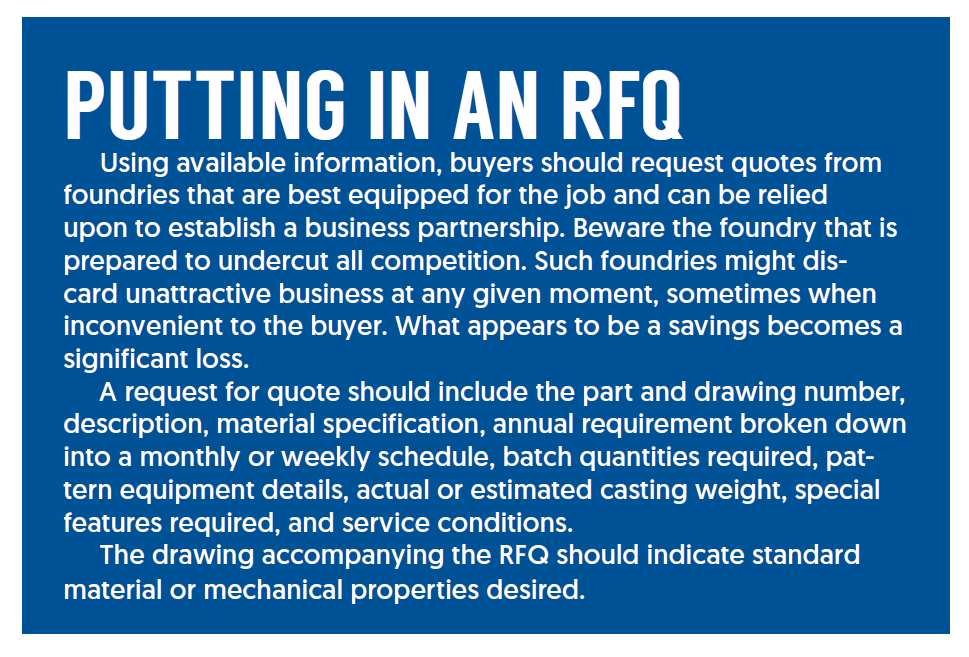7 Questions to Ask a Potential Casting Supplier
Narrow down the search for a new foundry with these basic questions.
Supply chain managers can find the names of casting suppliers from a variety of sources: supplier directories (see box on this page), advertising and marketing material, web searches, magazine articles, and recommendations from other buyers and engineering staff.
To gain the most reliable information about a casting source, it is worth taking an active role in seeking out specific information to match available foundry capacity with your sourcing needs. A few examples of the types of questions to ask potential foundries are listed in this article. The answers should be considered with care because they will reduce the scope of error and provide guidelines for future purchasing policy.
1. Which grades of metals are poured and what is the average tonnage output for each grade?
Obviously, you will want to know whether the casting supplier pours the type of metal you want for your part. But knowing the full picture of a foundry’s alloy options and melting operations will help paint a picture of how the foundry can serve your needs. Does it pour the grade of metal you need, but it only makes up a quarter of its total average output? That might factor into your lead time, because it is likely the foundry will wait to pour that grade until it has enough orders on the schedule to make it operationally efficient.
Perhaps you have a variety of parts to be cast in various grades. Opting for a foundry that can handle the multiple grades of metals will be advantageous.
2. Which molding processes and coremaking processes are offered?
If it is intended to buy heavily cored castings, look for the supplier that produces this type of casting. Forward-looking foundries are willing to provide advice on casting design, choice of material, and even foundry process. Mutual trust is needed to ensure the foundry is using complete objectivity in the advice, and in return, the foundry may wish to have the opportunity of recovering the cost of this service in the volume of sales. However, most foundries understand they do well by only accepting orders which fit their production profitably and will advise if a part is better suited in another process, material or design.

3. Which flask sizes are available and what is the casting weight range?
Flask size can affect the price and quality of castings. If possible, when designing castings, keep in mind the flask size to maximize the number of patterns on a plate. This will be a significant step in the process of cost reduction. When a new pattern is developed with a casting supplier, the pattern will fit a specific flask size. If you move the tooling to another foundry in the future, it must also be able to accommodate that flask size.
4. How many quality control personnel are on staff, and what is that in terms of percentage of total production staff?
Attitudes on quality can be assessed from the percentage of total production and quality control personnel directly involved in the quality control program. The buyer should recognize that a foundry’s strong emphasis on quality control indicates they are probably producing very high-grade castings. Its price structure will reflect this no matter whether castings of exceptionally high standards are required.
5. Which value-added capabilities does the foundry offer?
A number of North American foundries offer additional services beyond supplying a raw casting, including prototyping and machining. Consideration to the purchase of machined complete castings should be given when the material has unusual properties requiring specialized machining techniques, castings have to be subjected to testing and cleaning using specialized equipment, there is insufficient machining capacity at the customer’s facility, or the transportation costs of raw castings are prohibitive.
6. What is the foundry’s preferred casting size, quantity, and grade of metal?
Perhaps the most important point, when all other conditions have been satisfied, is to look at the foundry’s pattern of production. Is it high volume, small castings, or jobbing?
Each foundry has an optimal zone of production, and parts that fit this zone will be produced most cost effectively and expediently at that facility.
7. What are the foundry’s future plans for development?
A foundry with plans for expansion, equipment upgrades, or other business improvements is likely a healthy foundry that could grow and adapt with your business. However, in the short-term, certain development plans can affect delivery times.
A frank discussion with the foundry about its construction plans as well as your best estimated order projections will help avoid costly delays.
This article is based on a chapter from the Casting Buyer’s Guide, published by the American Foundry Society.
Click here to see this story as it appears in the November/December 2019 issue of Casting Source.